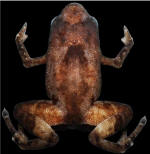Napoli, M. F.; Encarnação, L. C.; Cunha, M. S.; Abreu, R.
O.; Herrera, J. 2011. Paradoxical geographic distributions,
new record, and corrections of Bokermannohyla circumdata
(Cope, 1870) and B. caramaschii (Napoli, 2005)
(Amphibia: Anura: Hylidae). Herpetology Notes,
4:105–109.
|

Bokermannohyla circumdata
|
Abstract.
Surveys of amphibians in a coastal Atlantic Rainforest
remnant in southern Bahia, north-eastern Brazil, known as
Serra Bonita, resulted in the collection of specimens of
Bokermannohyla circumdata, which is the first record of
the species for the State of Bahia, and the northernmost
record for the coastal Atlantic Rainforest. Our results also
reject the occurrence of B. caramaschii in the
Serra Bonita Mountain, and the occurrence of B.
circumdata in the northern sector of the Serra da
Mantiqueira mountain range.
|
Xavier, A. L.; Napoli, M. F. 2011. Contribution of
environmental variables to anuran community structure in the
Caatinga Domain of Brazil. Phyllomedusa
10(1): 45–64.
|
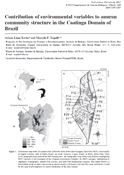
Localização e Poligonal do Parque Estadual das Sete
Passagens
Município de Miguel Calmon, Estado da Bahia, Brasil.
|
Abstract
.To ascertain the influence of environmental variables on
the structure of anuran communities, we conducted tests to
determine which variables best explain the spatial
distribution patterns of different communities of anurans in
a rocky, montane environment characterized mainly by open
habitats and gallery forests. The study area is the Sete
Passagens State Park (PESP) in the State of Bahia, Brazil,
an area included in the Chapada Diamantina Region and in the
Caatinga Morphoclimatic Domain. We sampled 20 plots (60 × 25
m) during two rainy seasons, and measured 13 environmental
variables. The environmental matrix was reduced to four
synthetic axes through the principal component analysis
(PCA), and the anuran community matrix was reduced to a
synthetic axis through the non-metric multidimensional
scaling method (NMS). We tested the association between
environmental axes (PCA, independent variables) and
community composition (NMS axis, dependent variable) using a
multiple regression analysis. The single axis significantly
associated with the species of anurans found in any given
plot is PC1, in which the major contributors to variation
are factors involving vegetation structure, listed in
descending order, as follow: percentage of leaf litter,
density of trees, canopy height, soil moisture, and
percentage of understory, shrub, and herb layers. The
ordination of the anuran community showed an environmental
gradient from the Campo Rupestre to Semi-deciduous Forest
patches, characterized mainly by the gradual increase of
layering in the vegetation.
 |
Napoli, M. F.; Cruz, C. A. G.; Abreu, R. O.;
Del-Grande, M. L. 2011. A new species of Proceratophrys
Miranda-Ribeiro (Amphibia: Anura: Cycloramphidae) from the
Chapada Diamantina, State of Bahia, northeastern Brazil .
Zootaxa 3133:
37–49.
|
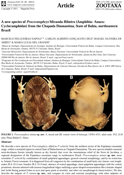
|
Abstract.
We describe a new species of Proceratophrys, allied
to P. schirchi, from the northern sector of the
Espinhaço mountain range, within a semiarid region in
central State of Bahia known as Chapada Diamantina. The new
species inhabits seasonal semi-deciduous forests (usually
known as dry forests) that cover the mountainous relief of
the Serra de Jacobina, a regional designation of the
Espinhaço mountain range in northeastern Brazil.
Proceratophrys minuta sp. nov. most resembles P.
schirchi by combination of small palpebral appendages,
general external morphology, and by its restriction to
Atlantic Forest remnants. It is diagnosed from all congeners
by the combination of small body size (snout–vent length,
males 20.4–25.2 mm, females 28.3–31.9 mm), absence of
rostral appendage, short palpebral appendages with the
central prominent, dorsum adorned with sinuous longitudinal
ridges outlining a spear-shaped ornamentation like a
hastate-shaped leaf (with flaring pointed lobes at eyes and
spear point at urostile), and other six morphological
characteristics. We also describe the tadpole of P.
minuta sp. nov., and compare its color and external
morphology with other tadpoles of Proceratophrys
described in the literature.

Resumo. Descrevemos uma nova espécie de
Proceratophrys, semelhante a P. schirchi,
proveniente do setor norte da Serra do Espinhaço, em região
semiárida no centro do Estado da Bahia conhecida como
Chapada Diamantina. A nova espécie habita florestas
estacionais semideciduais (usualmente conhecidas como
florestas secas) que cobrem o relevo montanhoso da Serra de
Jacobina, designação regional da Serra do Espinhaço no
nordeste do Brasil. Proceratophrys minuta sp. nov.
mais se assemelha a P. schirchi pela combinação de
apêndices palpebrais pequenos, aspecto geral da morfologia
externa e por sua restrição a remanescentes de Floresta
Atlântica. É diagnosticado de todos os congêneres pela
combinação do tamanho corpóreo pequeno (comprimento
rostro-cloacal, machos 20,4–25,2 mm, fêmeas 28,3–31,9 mm),
ausência de apêndice rostral, apêndices palpebrais curtos e
com o central proeminente, dorso adornado com cristas
longitudinais sinuosas delineando ornamentação lanceolada
semelhante à folha hastada (com lobos divergentes e
pontiagudos junto aos olhos e ponta da lança junto ao
uróstilo) e outras seis características morfológicas. Também
descrevemos o girino de P. minuta sp. nov. e
comparamos sua cor e morfologia externa com outros girinos
de Proceratophrys descritos na literatura. |
Caramaschi, U. & Napoli, M. F. 2012. Taxonomic revision
of the Odontophrynus cultripes species group, with
description of a new related species (Anura,
Cycloramphidae). Zootaxa 3155: 1-20.
|
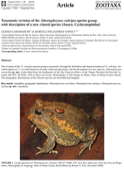
|
Abstract.
The revision of the O. cultripes species group is
presented, through the definition and characterization of
O. cultripes, the redescription of O. carvalhoi
based on recently collected specimens, and the description
of a new species. Odontophrynus monachus sp. nov.
is described from the headwaters of the São Francisco River,
in the Parque Nacional da Serra da Canastra (20o10'S,
46o30'W, 1350 m above sea level), Municipality of
São Roque de Minas, State of Minas Gerais, Brazil. The
geographic distributions of the referred species are
described and mapped.

Resumo. A revisão das espécies do grupo de
O. cultripes é apresentada, com definição e
caracterização de O. cultripes, redescrição de
O. carvalhoi com base em exemplares recentemente
obtidos e descrição de uma nova espécie. Odontophrynus
monachus sp. nov. é descrita das cabeceiras do Rio São
Francisco, no Parque Nacional da Serra da Canastra (20o10’S,
46o30’W, 1350 m acima do nível do mar), Município
de São Roque de Minas, Estado de Minas Gerais, Brasil. As
distribuições geográficas das espécies são atualizadas e
mapeadas. |
Camardelli, M. & Napoli, M. F. 2012. Amphibian
Conservation in the Caatinga Biome and Semiarid Region of
Brazil. Herpetologica, 68(1): 31-47.
|
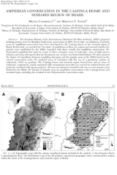
|
Abstract.
The Brazilian Ministry of the Environment (Ministério do
Meio Ambiente, MMA) proposed defining priority areas for
Brazilian biodiversity conservation in 2007, but to date, no
definitions of priority areas for amphibian conservation
have been developed for the Caatinga biome or the semiarid
region of Brazil. In this study, we searched for ‘‘hot
spots’’ of amphibians in these two regions and assessed
whether the priority areas established by the MMA coincided
with those suitable for amphibian conservation. We
determined amphibian hot spots by means of three estimates:
areas of endemism, areas of high species richness, and areas
with species that are threatened, rare, or have very limited
distributions. We then assessed the degree of coincidence
between amphibian hot spots and the priority areas of the
MMA based on the current conservation units. We analyzed
areas of endemism with the use of a parsimony analysis of
endemicity (PAE) on quadrats. The Caatinga biome and
semiarid region showed four and six areas of endemism,
respectively, mainly associated with mountainous areas that
are covered by isolated forests and positively correlated
with species richness. All areas of endemism coincided with
one or more priority areas defined by the MMA. We identify
15 priority areas for amphibian conservation in the Caatinga
biome and semiarid region, including the creation of new
full-protection conservation units.

Resumo. A definição de áreas prioritárias
para a conservação da biodiversidade brasileira foi proposta
pelo Ministério do Meio Ambiente (MMA) em 2007, mas até o
presente momento não há estudo metódico que defina áreas
prioritárias para a conservação de anfíbios no bioma
Caatinga ou no Semiárido brasileiro. Neste estudo, buscamos
por ‘‘hot spots’’ de anfíbios nestes dois polígonos e
verificamos se as áreas prioritárias do MMA coincidem com
áreas adequadas para a conservação dos anfíbios.
Determinamos os hot spots de anfı´bios por meio de três
estimadores: áreas de endemismo, áreas de alta riqueza de
espécies e áreas com espécies ameaçadas, raras e/ou com
padrões de distribuição restrita. Em seguida, acessamos o
grau de coincidência entre hot spots de anfíbios e áreas
prioritárias do MMA, igualmente considerando as unidades de
conservação correntemente instaladas. A detecção de áreas de
endemismo foi realizada pela Análise de Parcimônia de
Endemicidade (PAE), usando quadrados. O bioma Caatinga e o
Semiárido apresentaram, respectivamente, quatro e seis áreas
de endemismo, principalmente associadas a áreas montanhosas
cobertas por florestas isoladas, e estiveram positivamente
correlacionadas à riqueza de espécies. Todas as áreas de
endemismo coincidiram com uma ou mais áreas prioritárias
definidas pelo MMA. Nós identificamos 15 áreas prioritárias
para conservação de anfíbios no bioma Caatinga e Semiárido,
além da criação de novas unidades de conservação de proteção
integral no Brasil. |

